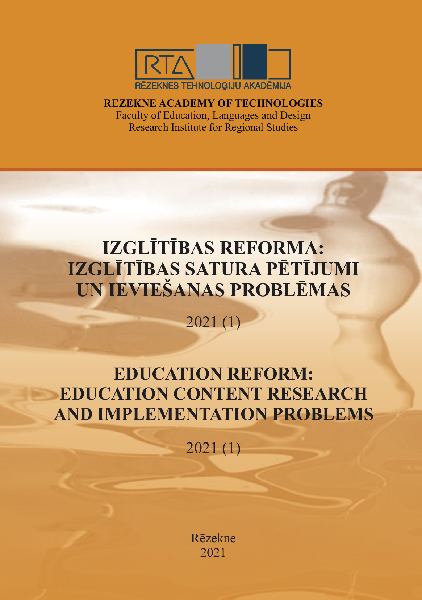DIGITAL TEACHING AID FOR THE DEVELOPMENT OF SPATIAL AWARENESS FOR CHILDREN WITH MIXED DEVELOPMENTAL DISORDERS
DOI:
https://doi.org/10.17770/er2021.1.6501Keywords:
spatial awareness, children with mixed developmental disorders, digital teaching aid.Abstract
Children with mixed developmental disorders have impaired spatial perception. When performing correction work with these children, it is necessary to look for the most effective means to achieve the maximum developmental result. The use of various non-traditional methods and techniques in teaching eliminates children's fatigue, stimulates their cognitive activity, allows optimizing the pedagogical process, individualizes teaching and significantly improves the effectiveness of pedagogical work in general. One of the ways is digital teaching aids that are systematically and purposefully integrated into correction work.
The aim of the paper is to theoretically substantiate the adequacy of the digital teaching aid developed by I. Zulbina for the formation of spatial awareness for children with mixed developmental disorders in preschool.
References
Alekso, V. A. (2011). Play material in visual perception development. Psychological Science and Education, 16(2), 62-70. Retrieved from
https://psyjournals.ru/files/44295/psyedu_2011_n2_Alekso.pdf
Anan'ev, B.G. & Rybalko, E.F. (1964). Osobennosti vosprijatija prostranstva u detej. M.: Prosveshhenie.
Dushkov, B.A., Korolev, A.V, & Smirnov, B.A. (2005). Psihologija truda, professional'noj, informacionnoj i organizacionnoj dejatel'nosti: Slovar'. 3-e izd. M.: Delovaja kniga.
Fisher, K. R., Hirsh‐Pasek, K., Newcombe, N., & Golinkoff, R. M. (2013). Taking shape: Supporting preschoolers' acquisition of geometric knowledge through guided play. Child development, 84(6), 1872-1878. Retrieved from https://templeinfantlab.com/wp-content/uploads/sites/2/2019/06/Fisher_et_al-2013-Child_Development.pdf
Gunderson, E. A., Ramirez, G., Beilock, S. L., & Levine, S. C. (2012). The relation between spatial skill and early number knowledge: the role of the linear number line. Developmental psychology, 48(5), 1229. Retrieved from
https://pdfs.semanticscholar.org/3ab3/2f8eab6726c1b19af5196db322025ab950f7.pdf
Internasjonal anatomisk nomenklatur: beskrivelse, grunnleggende begrep og interessante fakta. Anatomisk terminologi. Akser og fly (n.d.).Retieved from: https://scribes.ru/no/international-anatomical-nomenclature-description-basic-terms-and-interesting-facts-anatomical-terminologysss.html
Jakimanskaja, I.S. (1980). Razvitie prostranstvennogo myshlenija shkol'nikov. M.: Pedagogika
Jeleckaja, O.V., Matveeva M.V., & Tarakanova A.A. (2019). Informacionnye tehnologii v special'nom obrazovanii. M.: Izdatel'stvo VLADOS.
Keefe-Cooperman, K. (2016). Digital media and preschoolers: Implications for visual spatial development. Retrieved from https://digitalcommons.liu.edu/cgi/viewcontent.cgi? article=1003&context=post_coundfpub
Kondrova, A. (2010). Kognitīvo procesu sistēma. Palīgmateriāls skolotājam. Vārdnīca. Uzdevumi. Latvijas Universitātes realizētā projekta „Profesionālajā izglītībā iesaistīto vispārizglītojošo mācību priekšmetu pedagogu kompetences paaugstināšana”. Rīga.
Maklakovs, A.G. (2009). Obshhaja psihologija. Uchebnik dlja vuzov. SPb.: Piter.
Musejibova, T.A. (1994). Genezis otrazhenija prostranstva i prostranstvennyh orientacij u detej doshkol'nogo vozrasta. Teorija i metodika razvitija jelementarnyh matematicheskih predstavlenij u doshkol'nikov: Hrestomatija v 6 chastjah. SPb.: Piter.
Orska, R. & Olutnika, A. (2008). Bērns ar attīstības traucējumiem vispārējās izglītības iestādē.. Rēzekne: Rēzeknes Augstskola.
Puchkova, D.A. (2017). Rol' komp'juternyh igr v razvitii poznavatel'noj dejatel'nosti detej starshego doshkol'nogo vozrasta. Retrieved from https://www.science-education.ru/ru/article/view?id=17583
Semago, N.J. & Semago M.M. (2000). Problemnye deti: Osnovy diagnosticheskoj i korrekcionnoj raboty psihologa. M.: ARKTI.
Spector, J.M. (2014). Conceptualizing the emerging field of smart learning environments. Smart learning environments, 1(1), 2. Retrieved from https://slejournal.springeropen.com/articles/10.1186/s40561-014-0002-7
Tokki, E.I., & Pange, J. (2010). E-learning activities for articulation in speech language therapy and learning for preschool children. Procedia - Social and Behavioral Sciences, 2(2), 4274-4278. DOI: https://doi.org/10.1016/j.sbspro.2010.03.678
Trifunović, A., Pešić, D., Čičević, S., & Antić, B. (2017). The importance of spatial orientation and knowledge of traffic signs for children's traffic safety. Accident Analysis & Prevention, 102, 81-92. DOI: https://doi.org/10.1016/j.aap.2017.02.019
Tūbele, S., Landra T., Šūmane I., Burčaka M., Laganovska E., Kušnere S., & Vīgante R. (2013). Metodiskais materiāls pedagogiem darbam ar izglītojamiem, kuriem ir mācīšanās traucējumi un redzes traucējumi. Rīga: VISC.
Verdine, B. N., Bunger, A., Athanasopoulou, A., Golinkoff, R. M., & Hirsh-Pasek, K. (2017). Shape up: An eye-tracking study of preschoolers’ shape name processing and spatial development. Developmental Psychology, 53(10), 1869–1880. DOI: https://doi.org/10.1037/dev0000384
Zhang, X., & Lin, D. (2015). Pathways to arithmetic: The role of visual-spatial and language skills in written arithmetic, arithmetic word problems, and nonsymbolic arithmetic. Contemporary Educational Psychology, 41, 188-197. DOI: https://doi.org/10.1016/j.cedpsych.2015.01.005
Wu, C.S.T., Fowler, C., Lam, W.Y.Y., Wong, H.T., Wong, C.H.M., & Loke, A.Y. (2014). Parenting approaches and digital technology use of preschool age children in a Chinese community. Italian Journal of Pediatrics, 40, 1-8. DOI: https://doi.org/10.1186/1824-7288-40-44






